Monitoring NDVI Inter-Annual Behavior in Mountain Areas of Mainland Spain (2001–2016)
Abstract
:1. Introduction
- Analyzing if significantly temporal NDVI short-term trends (2001–2016) occurred in the mainland Spanish mountains.
- Studying if the possible patterns indicate a growing or decreasing trend for the different ranges due to their different climatic and vegetative conditions.
- Studying if there exists an association between NDVI significant trends and location in protected or unprotected mountain areas.
- Analyzing a possible association between NDVI trends and land cover types from mainland Spain.
- Calculating if land cover changes occurred between 2000–2006 and 2006–2012 in every mountain zone, which could explain the possible NDVI trends in every mountainous area.
2. Materials and Methods
2.1. Study Area
2.2. CORINE (Co-Ordination of Information on the Environment) Land Cover Maps
2.3. The NDVI from the Applied MODIS Dataset Used
2.4. Smoothing Normalized Difference Vegetation Index (NDVI) Pixel Curves in Spain with TIMESAT Software (Filtering Noise NDVI Profiles)
2.5. Temporal Trend Analyses
3. Results
3.1. Temporal Normalized Difference Vegetation Index (NDVI) Trend along Different Altitudes
3.2. Temporal Normalized Difference Vegetation Index (NDVI) Trend along Different Mountains and Protected Areas
3.3. Temporal Normalized Difference Vegetation Index (NDVI) Trends with Pure Pixels of Cover Types
3.4. Land Cover Change (2000–2006 and 2006–2012)
4. Discussion
5. Conclusions
Author Contributions
Funding
Acknowledgments
Conflicts of Interest
References
- Grêt-Regamey, A.; Brunner, S.H.; Kienast, F. Mountain ecosystem services: Who cares? Mt. Res. Dev. 2012, 32, S23–S34. [Google Scholar] [CrossRef]
- Pepin, N.; Bradley, R.S.; Diaz, H.F.; Baraër, M.; Caceres, E.B.; Forsythe, N.; Fowler, H.; Greenwood, G.; Hashmi, M.Z.; Liu, X.D. Elevation-dependent warming in mountain regions of the world. Nat. Clim. Chang. 2015, 5, 424–430. [Google Scholar] [Green Version]
- Barry, R.G.; Chorley, R.J. Atmosphere, Weather and Climate; Routledge: London, UK, 2009. [Google Scholar]
- DeBeer, C.M.; Pomeroy, J.W. Modelling snow melt and snowcover depletion in a small alpine cirque, Canadian rocky mountains. Hydrol. Process. Int. J. 2009, 23, 2584–2599. [Google Scholar] [CrossRef]
- Dyurgerov, M.B. Mountain glaciers are at risk of extinction. In Global Change and Mountain Regions; Springer: Dordrecht, The Netherlands, 2005; pp. 177–184. [Google Scholar]
- Salerno, F.; Rogora, M.; Balestrini, R.; Lami, A.; Tartari, G.A.; Thakuri, S.; Godone, D.; Freppaz, M.; Tartari, G. Glacier melting increases the solute concentrations of Himalayan glacial lakes. Environ. Sci. Technol. 2016, 50, 9150–9160. [Google Scholar] [CrossRef] [PubMed]
- Foster, P. The potential negative impacts of global climate change on tropical montane cloud forests. Earth-Sci. Rev. 2001, 55, 73–106. [Google Scholar] [CrossRef]
- Tasser, E.; Leitinger, G.; Tappeiner, U. Climate change versus land-use change? What affects the mountain landscapes more? Land Use Policy 2013, 60, 60–72. [Google Scholar] [CrossRef]
- Grabherr, G. Alpine vegetation dynamics and climate change—A synthesis of long-term studies and observations. In Alpine Biodiversity in Europe; Springer: Berlin/Heidelberg, Germany, 2003; pp. 399–409. [Google Scholar]
- Körner, C. Mountain biodiversity, its causes and function. Ambio 2004, 13, 11–17. [Google Scholar]
- Gehrig-Fasel, J.; Guisan, A.; Zimmermann, N.E. Tree line shifts in the Swiss Alps: Climate change or land abandonment? J. Veg. Sci. 2007, 18, 571–582. [Google Scholar] [CrossRef]
- Schröter, D.; Cramer, W.; Leemans, R.; Prentice, C.I.; Araújo, M.B.; Arnell, N.W.; Bondeau, A.; Bugmann, H.; Carter, T.R.; Gracia, C.A. Ecosystem service supply and vulnerability to global change in Europe. Science 2005, 310, 1333–1337. [Google Scholar] [CrossRef] [PubMed]
- Ruiz-Labourdette, D.; Nogués-Bravo, D.; Ollero, H.S.; Schmitz, M.F.; Pineda, F.D. Forest composition in Mediterranean mountains is projected to shift along the entire elevational gradient under climate change. J. Biogeogr. 2012, 39, 162–176. [Google Scholar] [CrossRef]
- Dudley, N. Guidelines for Applying Protected Area Management Categories; International Union for Conservation of Nature (IUCN): Grand, Switzerland, 2008. [Google Scholar]
- Rodríguez-Rodríguez, D.; Martínez-Vega, J. Evaluación de la Eficacia de las Áreas Protegidas; Fundación BBVA: Bilbao, Spain, 2013. [Google Scholar]
- Múgica, M.; Martínez, C.; Atauri, J.A.; Gómez-Limón, J.; Puertas, J.; García, D. Anuario del estado de las áreas Protegidas en España; EUROPARC-España: Madrid, Spain, 2017; p. 135. [Google Scholar]
- Rodríguez-Rodríguez, D.; Martínez-Vega, J. Protected area effectiveness against land development in Spain. J. Environ. Manag. 2018, 215, 345–357. [Google Scholar] [CrossRef] [PubMed] [Green Version]
- Atauri, J.A.; De Lucio, J.V. The role of landscape structure in species richness distribution of birds, amphibians, reptiles and lepidopterans in Mediterranean landscapes. Landsc. Ecol. 2001, 16, 147–159. [Google Scholar] [CrossRef]
- Rodríguez-Rodríguez, D.; Martínez-Vega, J.; Tempesta, M.; Otero-Villanueva, M.M. Limited uptake of protected area evaluation systems among managers and decision-makers in Spain and the Mediterranean sea. Environ. Conserv. 2015, 42, 237–245. [Google Scholar] [CrossRef]
- Foley, J.A.; Asner, G.P.; Costa, M.H.; Coe, M.T.; DeFries, R.; Gibbs, H.K.; Howard, E.A.; Olson, S.; Patz, J.; Ramankutty, N. Amazonia revealed: Forest degradation and loss of ecosystem goods and services in the amazon basin. Front. Ecol. Environ. 2007, 5, 25–32. [Google Scholar] [CrossRef]
- Pettorelli, N.; Vik, J.O.; Mysterud, A.; Gaillard, J.-M.; Tucker, C.J.; Stenseth, N.C. Using the satellite-derived NDVI to assess ecological responses to environmental change. Trends Ecol. Evol. 2005, 20, 503–510. [Google Scholar] [CrossRef] [PubMed]
- Sannier, C.A.D.; Taylor, J.C.; Plessis, W.D. Real-time monitoring of vegetation biomass with NOAA-AVHRR in Etosha National Park, Namibia, for fire risk assessment. Int. J. Remote Sens. 2002, 23, 71–89. [Google Scholar] [CrossRef]
- Turner, D.P.; Ritts, W.D.; Cohen, W.B.; Gower, S.T.; Zhao, M.; Running, S.W.; Wofsy, S.C.; Urbanski, S.; Dunn, A.L.; Munger, J.W. Scaling gross primary production (GPP) over boreal and deciduous forest landscapes in support of MODIS GPP product validation. Remote Sens. Environ. 2003, 88, 256–270. [Google Scholar] [CrossRef]
- Mallegowda, P.; Rengaian, G.; Krishnan, J.; Niphadkar, M. Assessing habitat quality of forest-corridors through ndvi analysis in dry tropical forests of south India: Implications for conservation. Remote Sens. 2015, 7, 1619–1639. [Google Scholar] [CrossRef]
- Gillespie, T.W.; Ostermann-Kelm, S.; Dong, C.; Willis, K.S.; Okin, G.S.; MacDonald, G.M. Monitoring changes of NDVI in protected areas of southern California. Ecol. Indic. 2018, 88, 485–494. [Google Scholar] [CrossRef]
- Janssen, T.A.J.; Ametsitsi, G.K.D.; Collins, M.; Adu-Bredu, S.; Oliveras, I.; Mitchard, E.T.A.; Veenendaal, E.M. Extending the baseline of tropical dry forest loss in Ghana (1984–2015) reveals drivers of major deforestation inside a protected area. Boil. Conserv. 2018, 218, 163–172. [Google Scholar] [CrossRef]
- Pettorelli, N.; Chauvenet, A.L.M.; Duffy, J.P.; Cornforth, W.A.; Meillere, A.; Baillie, J.E.M. Tracking the effect of climate change on ecosystem functioning using protected areas: Africa as a case study. Ecol. Indic. 2015, 20, 269–276. [Google Scholar] [CrossRef]
- Nagendra, H.; Lucas, R.; Honrado, J.O.P.; Jongman, R.H.G.; Tarantino, C.; Adamo, M.; Mairota, P. Remote sensing for conservation monitoring: Assessing protected areas, habitat extent, habitat condition, species diversity, and threats. Ecol. Indic. 2013, 33, 45–59. [Google Scholar] [CrossRef]
- Peng, S.; Chen, A.; Xu, L.; Cao, C.; Fang, J.; Myneni, R.B.; Pinzon, J.E.; Tucker, C.J.; Piao, S. Recent change of vegetation growth trend in China. Environ. Res. Lett. 2011, 6, 044027. [Google Scholar] [CrossRef]
- Wen, Z.; Wu, S.; Chen, J.; Lü, M. NDVI indicated long-term interannual changes in vegetation activities and their responses to climatic and anthropogenic factors in the three gorges reservoir region, China. Sci. Total Environ. 2016, 574, 947–959. [Google Scholar] [CrossRef] [PubMed]
- Sellers, P.J. Canopy reflectance, photosynthesis and transpiration. Int. J. Remote Sens. 1985, 6, 1335–1372. [Google Scholar] [CrossRef] [Green Version]
- Running, S.W.; Nemani, R.R.; Heinsch, F.A.; Zhao, M.; Reeves, M.; Hashimoto, H. A continuous satellite-derived measure of global terrestrial primary production. BioScience 2004, 54, 547–560. [Google Scholar] [CrossRef]
- Myneni, R.B.; Keeling, C.D.; Tucker, C.J.; Asrar, G.; Nemani, R.R. Increased plant growth in the northern high latitudes from 1981 to 1991. Nature 1997, 386, 698–702. [Google Scholar] [CrossRef]
- Zhang, X.; Friedl, M.A.; Schaaf, C.B.; Strahler, A.H.; Hodges, J.C.F.; Gao, F.; Reed, B.C.; Huete, A. Monitoring vegetation phenology using MODIS. Remote Sens. Environ. 2003, 84, 471–475. [Google Scholar] [CrossRef]
- Stöckli, R.; Vidale, P.L. European plant phenology and climate as seen in a 20-year AVHRR land-surface parameter dataset. Int. J. Remote Sens. 2004, 25, 3303–3330. [Google Scholar] [CrossRef] [Green Version]
- Busetto, L.; Colombo, R.; Migliavacca, M.; Cremonese, E.; Meroni, M.; Galvagno, M.; Rossini, M.; Siniscalco, C.; Morra Di Cella, U.; Pari, E. Remote sensing of larch phenological cycle and analysis of relationships with climate in the alpine region. Glob. Chang. Boil. 2010, 16, 2504–2517. [Google Scholar] [CrossRef]
- Colombo, R.; Busetto, L.; Fava, F.; Di Mauro, B.; Migliavacca, M.; Cremonese, E.; Galvagno, M.; Rossini, M.; Meroni, M.; Cogliati, S. Phenological monitoring of grassland and larch in the Alps from TERRA and AQUA MODIS images. Rivista Italiana di Telerilevamento 2011, 43, 83–96. [Google Scholar]
- Hmimina, G.; Dufrêne, E.; Pontailler, J.Y.; Delpierre, N.; Aubinet, M.; Caquet, B.; De Grandcourt, A.; Burban, B.; Flechard, C.; Granier, A. Evaluation of the potential of MODIS satellite data to predict vegetation phenology in different biomes: An investigation using ground-based NDVI measurements. Remote Sens. Environ. 2013, 132, 145–158. [Google Scholar] [CrossRef]
- Eklundh, L.; Johansson, T.; Solberg, S. Mapping insect defoliation in scots pine with MODIS time-series data. Remote Sens. Environ. 2009, 113, 1566–1573. [Google Scholar] [CrossRef]
- Sesnie, S.E.; Dickson, B.G.; Rosenstock, S.S.; Rundall, J.M. A comparison of LANDSAT TM and MODIS vegetation indices for estimating forage phenology in desert bighorn sheep (Ovis canadensis nelsoni) habitat in the Sonoran desert, USA. Int. J. Remote Sens. 2012, 33, 276–286. [Google Scholar] [CrossRef]
- Song, Y.; Song, C.; Li, Y.; Hou, C.; Yang, G.; Zhu, X. Short-term effects of nitrogen addition and vegetation removal on soil chemical and biological properties in a freshwater marsh in Sanjiang Plain, Northeast China. Catena 2013, 104, 265–271. [Google Scholar] [CrossRef]
- Vicente-Serrano, S.M.; Heredia-Laclaustra, A. Nao influence on NDVI trends in the Iberian Peninsula (1982–2000). Int. J. Remote Sens. 2004, 25, 2871–2879. [Google Scholar] [CrossRef]
- Lasanta-Martínez, T.; Vicente-Serrano, S.M.; Cuadrat-Prats, J.M. Mountain Mediterranean landscape evolution caused by the abandonment of traditional primary activities: A study of the Spanish central Pyrenees. Appl. Geogr. 2005, 25, 47–65. [Google Scholar] [CrossRef]
- Hill, J.; Stellmes, M.; Udelhoven, T.; Röder, A.; Sommer, S. Mediterranean desertification and land degradation: Mapping related land use change syndromes based on satellite observations. Glob. Planet. Chang. 2008, 64, 146–157. [Google Scholar] [CrossRef]
- Del Barrio, G.; Harrison, P.A.; Berry, P.M.; Butt, N.; Sanjuan, M.E.; Pearson, R.G.; Dawson, T. Integrating multiple modelling approaches to predict the potential impacts of climate change on species’ distributions in contrasting regions: Comparison and implications for policy. Environ. Sci. Policy 2006, 9, 129–147. [Google Scholar] [CrossRef]
- Khorchani, M.; Vicente-Serrano, S.M.; Azorin-Molina, C.; García, M.; Martín-Hernández, N.; Peña-Gallardo, M.; El Kenawy, A.; Domínguez-Castro, F. Trends in LST over the peninsular Spain as derived from the AVHRR imagery data. Glob. Planet. Chang. 2018, 166, 75–93. [Google Scholar] [CrossRef]
- Rivas-Martínez, S.; Gandullo, J.M.; Serrada, R.; Allué, J.L.; Montero, J.L.; González, J.L. Mapa de Series de Vegetación de España y Memoria; del Ministerio de Agricultura, Pesca y Alimentación: Madrid, Spain, 1987.
- Rivas-Martínez, S. Mapa de Series, Geoseries y Geopermaseries de Vegetación de España; Asociación Española de Fitosociología: Sarriena, Spain, 2007. [Google Scholar]
- Aliaga, F.T. Geografía física de España0; National University of Distance Education: Madrid, Spain, 2003; p. 454. [Google Scholar]
- Recio, R.; Manuel, J. Biogeografía. Paisajes Vegetales y vida Animal, 1st ed.; Editorial Sintesis: Madrid, Spain, 1988. [Google Scholar]
- García-Ruiz, J.M. Geoecología de las Áreas de Montaña; Geoforma Ediciones: Madrid, Spain, 1990. [Google Scholar]
- European Environment Agency (EEA). CLC 2006 Technical Guidelines; European Environment Agency: Copenhagen, Denmark, 2007. [Google Scholar]
- Tucker, C.J.; Sellers, P.J. Satellite remote sensing of primary production. Int. J. Remote Sens. 1986, 7, 1395–1416. [Google Scholar] [CrossRef] [Green Version]
- Myneni, R.B.; Williams, D.L. On the relationship between FAPAR and NDVI. Remote Sens. Environ. 1994, 49, 200–211. [Google Scholar] [CrossRef]
- Eastman, J.R. Terrset; Clark University: Worcester, UK, 2015. [Google Scholar]
- Didan, K. MOD13Q1 MODIS/Terra Vegetation Indices 16-day L3 Global 250m SIN Grid V006. Available online: https://lpdaac.usgs.gov/dataset_discovery/modis/modis_products_table/mod13a1_v006 (accessed on 21 November 2018).
- Jönsson, P.; Eklundh, L. Seasonality extraction by function fitting to time-series of satellite sensor data. IEEE Trans. Geosci. Remote Sens. 2002, 40, 1824–1832. [Google Scholar] [CrossRef]
- Erasmi, S.; Schucknecht, A.; Barbosa, M.P.; Matschullat, J. Vegetation greenness in northeastern Brazil and its relation to Enso warm events. Remote Sens. 2014, 6, 3041–3058. [Google Scholar] [CrossRef] [Green Version]
- Sen, P.K. Estimates of the regression coefficient based on Kendall’s Tau. J. Am. Stat. Assoc. 1968, 63, 1379–1389. [Google Scholar] [CrossRef]
- Fernandes, R.; Leblanc, S.G. Parametric (modified Least Squares) and non-parametric (Theil-Sen) linear regressions for predicting biophysical parameters in the presence of measurement errors. Remote Sens. Environ. 2005, 95, 303–316. [Google Scholar] [CrossRef]
- Mann, H.B. Nonparametric tests against trend. Econ. J. Econ. Soc. 1945, 13, 245–259. [Google Scholar] [CrossRef]
- Kendall, M.G. Rank Correlation Methods, 4th ed.; Griffin: London, UK, 1970; p. 160. [Google Scholar]
- Arrogante-Funes, P.; Novillo, C.J.; Romero-Calcerrada, R.; Vázquez-Jiménez, R.; Ramos-Bernal, R.N. Relationship between MRPV model parameters from MISRL2 land surface product and land covers: A case study within Mainland Spain. ISPRS Int. J. Geo-Inf. 2017, 6, 353. [Google Scholar] [CrossRef]
- Arrogante-Funes, P.; Novillo, C.J.; Romero-Calcerrada, R.; Vázquez-Jiménez, R.; Ramos-Bernal, R.N. Evaluation of the consistency of the three MRPV model parameters provided by the MISR level 2 land surface products: A case study in Mainland Spain. Int. J. Remote Sens. 2018, 39, 3164–3185. [Google Scholar] [CrossRef]
- Mendoza-Fernández, A.; Pérez-García, F.J.; Medina-Cazorla, J.M.; Martínez-Hernández, F.; Garrido-Becerra, J.A.; Sánchez, E.S.; Mota, J.F. Gap analysis and selection of reserves for the threatened flora of eastern Andalusia, a hot spot in the eastern Mediterranean region. Acta Bot. Gallica 2010, 157, 749–767. [Google Scholar] [CrossRef]
- Cowling, R.M.; Rundel, P.W.; Lamont, B.B.; Kalin Arroyo, M.; Arianoutsou, M. Plant diversity in Mediterranean-climate regions. Trends Ecol. Evol. 1996, 11, 362–366. [Google Scholar] [CrossRef]
- Blanca, G.; Cueto, M.; Martínez-Lirola, M.J.; Molero-Mesa, J. Threatened vascular flora of Sierra Nevada (Southern Spain). Boil. Conserv. 1998, 85, 269–285. [Google Scholar] [CrossRef]
- Pons, X.; Solé-Sugrañes, L. A simple radiometric correction model to improve automatic mapping of vegetation from multispectral satellite data. Remote Sens. Environ. 1994, 48, 191–204. [Google Scholar] [CrossRef]
- Florinsky, I.V.; Kuryakova, G.A. Influence of topography on some vegetation cover properties. Catena 1996, 27, 123–141. [Google Scholar] [CrossRef]
- Allen, C.D.; Macalady, A.K.; Chenchouni, H.; Bachelet, D.; McDowell, N.; Vennetier, M.; Kitzberger, T.; Rigling, A.; Breshears, D.D.; Hogg, E.H.T. A global overview of drought and heat-induced tree mortality reveals emerging climate change risks for forests. For. Ecol. Manag. 2004, 259, 660–684. [Google Scholar] [CrossRef]
- Bennie, J.; Hill, M.O.; Baxter, R.; Huntley, B. Influence of slope and aspect on long-term vegetation change in British chalk grasslands. J. Ecol. 2006, 94, 355–368. [Google Scholar] [CrossRef] [Green Version]
- Serra, J.M.; Cristobal, J.; Ninyerola, M. A classification procedure for mapping topo-climatic conditions for strategic vegetation planning. Environ. Model. Assess. 2011, 16, 77–89. [Google Scholar] [CrossRef]
- Moeslund, J.E.; Arge, L.; Bøcher, P.K.; Dalgaard, T.; Ejrnæs, R.; Odgaard, M.V.; Svenning, J.-C. Topographically controlled soil moisture drives plant diversity patterns within grasslands. Biodivers. Conserv. 2013, 22, 2151–2166. [Google Scholar] [CrossRef]
- Zhou, L.; Tucker, C.J.; Kaufmann, R.K.; Slayback, D.; Shabanov, N.V.; Myneni, R.B. Variations in northern vegetation activity inferred from satellite data of vegetation index during 1981 to 1999. J. Geophys. Res. Atmos. 2001, 106, 20069–20083. [Google Scholar] [CrossRef] [Green Version]
- Bogaert, J.; Farina, A.; Ceulemans, R. Entropy increase of fragmented habitats: A sign of human impact? Ecol. Indic. 2005, 5, 207–212. [Google Scholar] [CrossRef]
- Slayback, D.A.; Pinzon, J.E.; Los, S.O.; Tucker, C.J. Northern hemisphere photosynthetic trends 1982–99. Glob. Chang. Boil. 2003, 9, 1–15. [Google Scholar] [CrossRef]
- Liu, Y.Y.; Van Dijk, A.I.J.M.; De Jeu, R.A.M.; Canadell, J.G.; McCabe, M.F.; Evans, J.P.; Wang, G. Recent reversal in loss of global terrestrial biomass. Nat. Clim. Chang. 2015, 5, 470–474. [Google Scholar] [CrossRef]
- Xu, C.; Liu, H.; Williams, A.P.; Yin, Y.; Wu, X. Trends toward an earlier peak of the growing season in northern hemisphere middle-latitudes. Glob. Chang. Boil. 2016, 22, 2852–2860. [Google Scholar] [CrossRef] [PubMed]
- Alcaraz-Segura, D.; Liras, E.; Tabik, S.; Paruelo, J.; Cabello, J. Evaluating the consistency of the 1982-1999 NDVI trends in the Iberian peninsula across four time-series derived from the AVHRR sensor: LTDR, GIMMS, FASIR, and PAL-II. Sensors 2009, 10, 1291–1314. [Google Scholar] [CrossRef] [PubMed]
- Fensholt, R.; Langanke, T.; Rasmussen, K.; Reenberg, A.; Prince, S.D.; Tucker, C.; Scholes, R.J.; Le, Q.B.; Bondeau, A.; Eastman, R. Greenness in semi-arid areas across the globe 1981–2007: An earth observing satellite based analysis of trends and drivers. Remote Sens. Environ. 2012, 121, 144–158. [Google Scholar] [CrossRef]
- Rutishauser, T.; Luterbacher, J.; Jeanneret, F.; Pfister, C.; Wanner, H. A phenology-based reconstruction of interannual changes in past spring seasons. J. Geophys. Res. Biogeosci. 2007, 112. [Google Scholar] [CrossRef] [Green Version]
- Studer, S.; Stökli, R.; Appenzeller, C.; Vidale, P.L. A comparative study of satellite and ground-based phenology. Int. J. Biometeorol. 2007, 51, 405–414. [Google Scholar] [CrossRef] [PubMed]
- Delbart, N.; Picard, G.; Le Toan, T.; Kergoat, L.; Quegan, S.; Woodward, I.A.N.; Dye, D.; Fedotova, V. Spring phenology in boreal Eurasia over a nearly century time scale. Glob. Chang. Boil. 2008, 14, 603–614. [Google Scholar] [CrossRef]
- Lucht, W.; Prentice, I.C.; Myneni, R.B.; Sitch, S.; Friedlingstein, P.; Cramer, W.; Bousquet, P.; Buermann, W.; Smith, B. Climatic control of the high-latitude vegetation greening trend and Pinatubo effect. Science 2002, 296, 1687–1689. [Google Scholar] [CrossRef] [PubMed]
- Nemani, R.R.; Keeling, C.D.; Hashimoto, H.; Jolly, W.M.; Piper, S.C.; Tucker, C.J.; Myneni, R.B.; Running, S.W. Climate-driven increases in global terrestrial net primary production from 1982 to 1999. Science 2003, 300, 1560–1563. [Google Scholar] [CrossRef] [PubMed]
- Piao, S.; Fang, J.; Zhou, L.; Zhu, B.; Tan, K.; Tao, S. Changes in vegetation net primary productivity from 1982 to 1999 in China. Glob. Biogeochem. Cy. 2005, 19. [Google Scholar] [CrossRef] [Green Version]
- Jiapaer, G.; Yi, Q.; Yao, F.; Zhang, P. Comparison of non-destructive LAI determination methods and optimization of sampling schemes in an open Populus euphratica ecosystem. Urban For. Urban Green. 2017, 26, 114–123. [Google Scholar] [CrossRef]
- Montaldo, N.; Albertson, J.D.; Mancini, M. Vegetation dynamics and soil water balance in a water-limited Mediterranean ecosystem on Sardinia, Italy. Hydrol. Earth Syst. Sci. Discuss. 2008, 5, 219–255. [Google Scholar] [CrossRef]
- Tagesson, T.; Fensholt, R.; Cropley, F.; Guiro, I.; Horion, S.; Ehammer, A.; Ardö, J. Dynamics in carbon exchange fluxes for a grazed semi-arid savanna ecosystem in West Africa. Agric. Ecosyst. Environ. 2015, 205, 15–24. [Google Scholar] [CrossRef]
- Fischer, E.; Riggs, L.; Leitner, P.; Villablanca, F.; Leeman, T.; McCarten, N.; Rogers, C. Development of a Population-Based Habitat Suitability Model for Salt Marsh Harvest Mouse to Guide Restoration Efforts in the North Bay Region. Available online: https://www.google.com.tw/url?sa=t&rct=j&q=&esrc=s&source=web&cd=1&ved=2ahUKEwjst4PgueTeAhULw7wKHcEHAYcQFjAAegQIARAC&url=https%3A%2F%2Fnrm.dfg.ca.gov%2FFileHandler.ashx%3FDocumentID%3D5548&usg=AOvVaw2bneSWCkOnORLb88eM1QRK (accessed on 21 November 2018).
- Reichstein, M.; Bahn, M.; Ciais, P.; Frank, D.; Mahecha, M.D.; Seneviratne, S.I.; Zscheischler, J.; Beer, C.; Buchmann, N.; Frank, D.C. Climate extremes and the carbon cycle. Nature 2013, 500, 287–295. [Google Scholar] [CrossRef] [PubMed]
- Le Quere, C. Budget, global carbon. Earth Syst. Sci. Data 2016, 8, 605–649. [Google Scholar] [CrossRef]
- Zhu, Q.; Zhong, Y.; Zhao, B.; Xia, G.-S.; Zhang, L. Bag-of-visual-words scene classifier with local and global features for high spatial resolution remote sensing imagery. IEEE Geosci. Remote Sens. Lett. 2016, 13, 747–751. [Google Scholar] [CrossRef]
- Jiménez-Olivenza, Y.; Rodríguez-Porcel, L.; Calvo-Caballero, L. Medio siglo en la evolución de los paisajes naturales y agrarios de Sierra Nevada. Boletín de la Asociación de Geógrafos Españoles 2015, 68, 205–232. [Google Scholar]
- Vidal-Macua, J.J.; Zabala, A.; Ninyerola, M.; Pons, X. Developing spatially and thematically detailed backdated maps for land cover studies. Int. J. Digit. Earth 2017, 10, 175–206. [Google Scholar] [CrossRef]
- López-Moreno, J.I.; Morán-Tejeda, E.; Vicente Serrano, S.M.; Lorenzo-Lacruz, J.; García-Ruiz, J.M. Impact of climate evolution and land use changes on water yield in the Ebro Basin. Hydrol. Earth Syst. Sci. 2011, 15, 311–322. [Google Scholar] [CrossRef] [Green Version]
- Del Río, S.; Cano-Ortiz, A.; Herrero, L.; Penas, A. Recent trends in mean maximum and minimum air temperatures over Spain (1961–2006). Theor. Appl. Clim. 2011, 109, 605–626. [Google Scholar] [CrossRef]
- El Kenawy, A.; López-Moreno, J.I.; Vicente-Serrano, S.M. Trend and variability of surface air temperature in northeastern Spain (1920–2006): Linkage to atmospheric circulation. Atmos. Res. 2012, 106, 159–180. [Google Scholar] [CrossRef]
- Bernstein, L.; Bosch, P.; Canziani, O.; Chen, Z.; Christ, R.; Riahi, K. IPCC, 2007: Climate Change 2007: Synthesis Report; Intergovernmental Panel on Climate Change (IPCC): Geneva, Switzerland, 2008. [Google Scholar]
- Stocker, T.F.; Qin, D.; Plattner, G.K.; Tignor, M.; Allen, S.K.; Boschung, J.; Nauels, A.; Xia, Y.; Bex, V.; Midgley, P.M. IPCC, 2013: Climate Change 2013: The Physical Science Basis; Cambridge University Press: Cambridge, UK; New York, NY, USA, 2013; p. 1535. [Google Scholar]
- Gonzalez-Hidalgo, J.C.; López-Bustins, J.A.; Štepánek, P.; Martin-Vide, J.; de Luis, M. Monthly precipitation trends on the Mediterranean fringe of the Iberian Peninsula during the second-half of the twentieth century (1951–2000). Int. J. Clim. 2009, 29, 1415–1429. [Google Scholar] [CrossRef]
- Vicente-Serrano, S.M.; Lopez-Moreno, J.I.; Beguería, S.; Lorenzo-Lacruz, J.; Sanchez-Lorenzo, A.; Garcí-Ruiz, J.M.; Azorin-Molina, C.; Morán-Tejeda, E.; Revuelto, J.; Trigo, R. Evidence of increasing drought severity caused by temperature rise in southern Europe. Environ. Res. Lett. 2014, 9, 044001. [Google Scholar] [CrossRef] [Green Version]
- Vicente-Serrano, S.M.; Lasanta, T.; Romo, A. Analysis of spatial and temporal evolution of vegetation cover in the Spanish central Pyrenees: Role of human management. Environ. Manag. 2004, 34, 802–818. [Google Scholar] [CrossRef] [PubMed]
- Papagiannopoulou, C.; Miralles, D.G.; Dorigo, W.A.; Verhoest, N.E.C.; Depoorter, M.; Waegeman, W. Vegetation anomalies caused by antecedent precipitation in most of the world. Environ. Res. Lett. 2017, 12, 074016. [Google Scholar] [CrossRef] [Green Version]
- Karnieli, A.; Agam, N.; Pinker, R.T.; Anderson, M.; Imhoff, M.L.; Gutman, G.G.; Panov, N.; Goldberg, A. Use of NDVI and land surface temperature for drought assessment: Merits and limitations. J. Clim. 2010, 23, 618–633. [Google Scholar] [CrossRef]
- Canadell, J.G.; Le Quéré, C.; Raupach, M.R.; Field, C.B.; Buitenhuis, E.T.; Ciais, P.; Conway, T.J.; Gillett, N.P.; Houghton, R.A.; Marland, G. Contributions to accelerating atmospheric CO2 growth from economic activity, carbon intensity, and efficiency of natural sinks. Proc. Natl. Acad. Sci. USA 2007, 104, 18866–18870. [Google Scholar] [CrossRef] [PubMed] [Green Version]
- Martínez, B.; Gilabert, M.A. Vegetation dynamics from NDVI time series analysis using the wavelet transform. Remote Sens. Environ. 2009, 113, 1823–1842. [Google Scholar] [CrossRef]
- Vicente-Serrano, S.M.; Cuadrat, J.M. North Atlantic oscillation control of droughts in north-east Spain: Evaluation since 1600 ad. Clim. Chang. 2007, 85, 357–379. [Google Scholar] [CrossRef]
- Trouet, V.; Babst, F.; Meko, M. Recent enhanced high-summer north Atlantic Jet variability emerges from three-century context. Nat. Commun. 2018, 9, 180. [Google Scholar] [CrossRef] [PubMed]
- García-Ruiz, J.M.; Lana-Renault, N. Hydrological and erosive consequences of farmland abandonment in Europe, with special reference to the Mediterranean regional review. Agric. Ecosyst. Environ. 2011, 140, 317–338. [Google Scholar] [CrossRef]
- Blanco-Fontao, B.; Quevedo, M.; Obeso, J.R. Abandonment of traditional uses in mountain areas: Typological thinking versus hard data in the Cantabrian Mountains (NW Spain). Biodivers. Conserv. 2011, 20, 1133–1140. [Google Scholar] [CrossRef]
- Rodrigues, M.; Jiménez-Ruano, A.; Peña-Angulo, D.; de la Riva, J. A comprehensive spatial-temporal analysis of driving factors of human-caused wildfires in Spain using geographically weighted logistic regression. J. Environ. Manag. 2018, 225, 177–192. [Google Scholar] [CrossRef] [PubMed]
- Herrero, A.; Zavala, M.A. Los bosques y la Biodiversidad Frente al Cambio Climático: Impactos, Vulnerabilidad y Adaptación en España; Ministerio de Agricultura, Alimentación y Medio Ambiente: Madrid, Spain, 2015.
- Udelhoven, T.; Stellmes, M. Changes in land surface conditions on the Iberian Peninsula (1989 to 2004) detected by means of time series analysis from hypertemporal remote sensing data. In Proceedings of the 2007 International Workshop on the Analysis of Multi-Temporal Remote Sensing Images (MultiTemp 2007), Leuven, Belgium, 18–20 July 2007; pp. 1–6. [Google Scholar]
- Martinez-Fernandez, J.; Ruiz-Benito, P.; Zavala, M.A. Recent land cover changes in Spain across biogeographical regions and protection levels: Implications for conservation policies. Land Use Pol. 2015, 44, 62–75. [Google Scholar] [CrossRef]
- Martinez-Fernandez, J.; Ceballos, A. Mean soil moisture estimation using temporal stability analysis. J. Hydrol. 2005, 312, 28–38. [Google Scholar] [CrossRef]
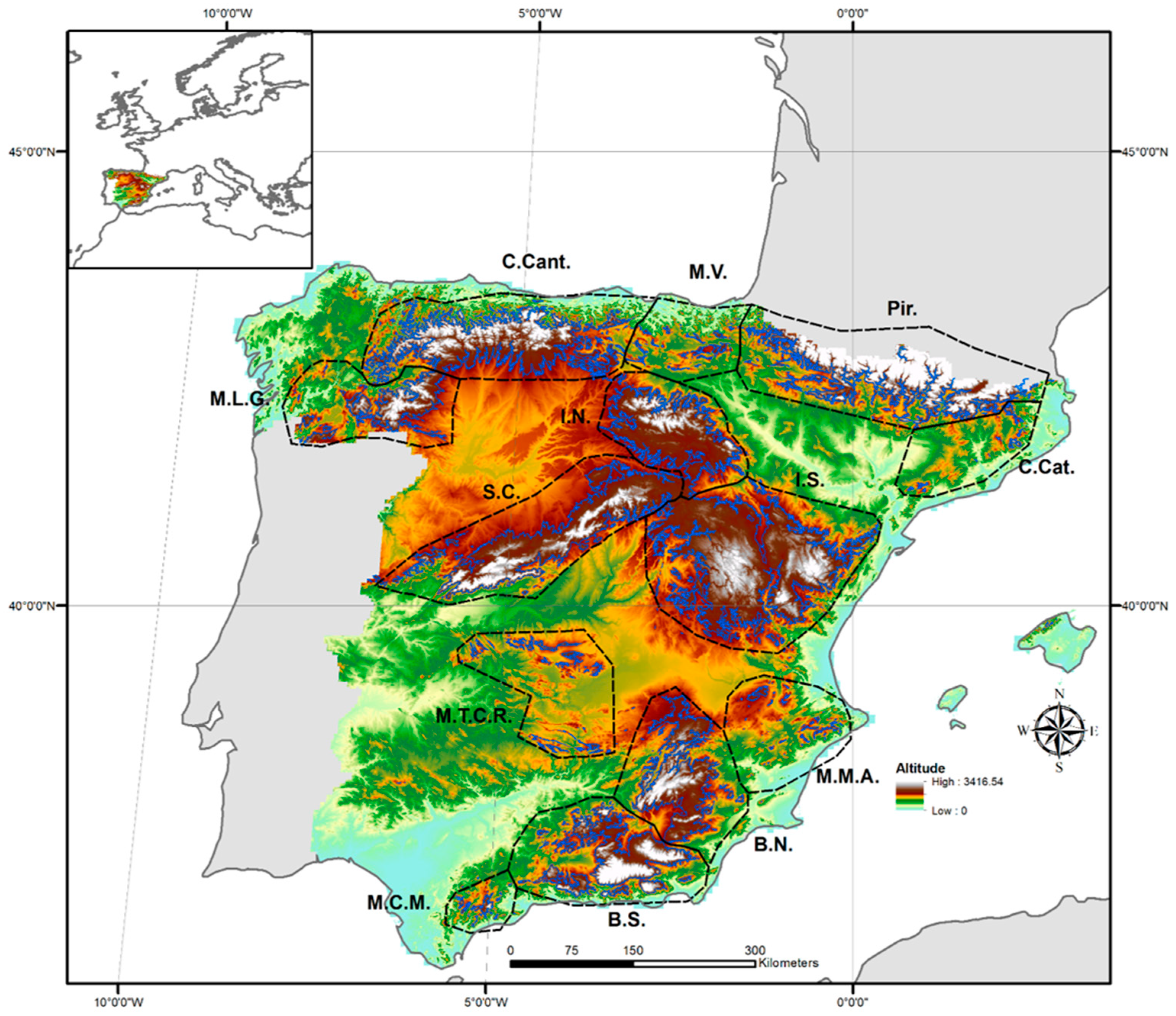
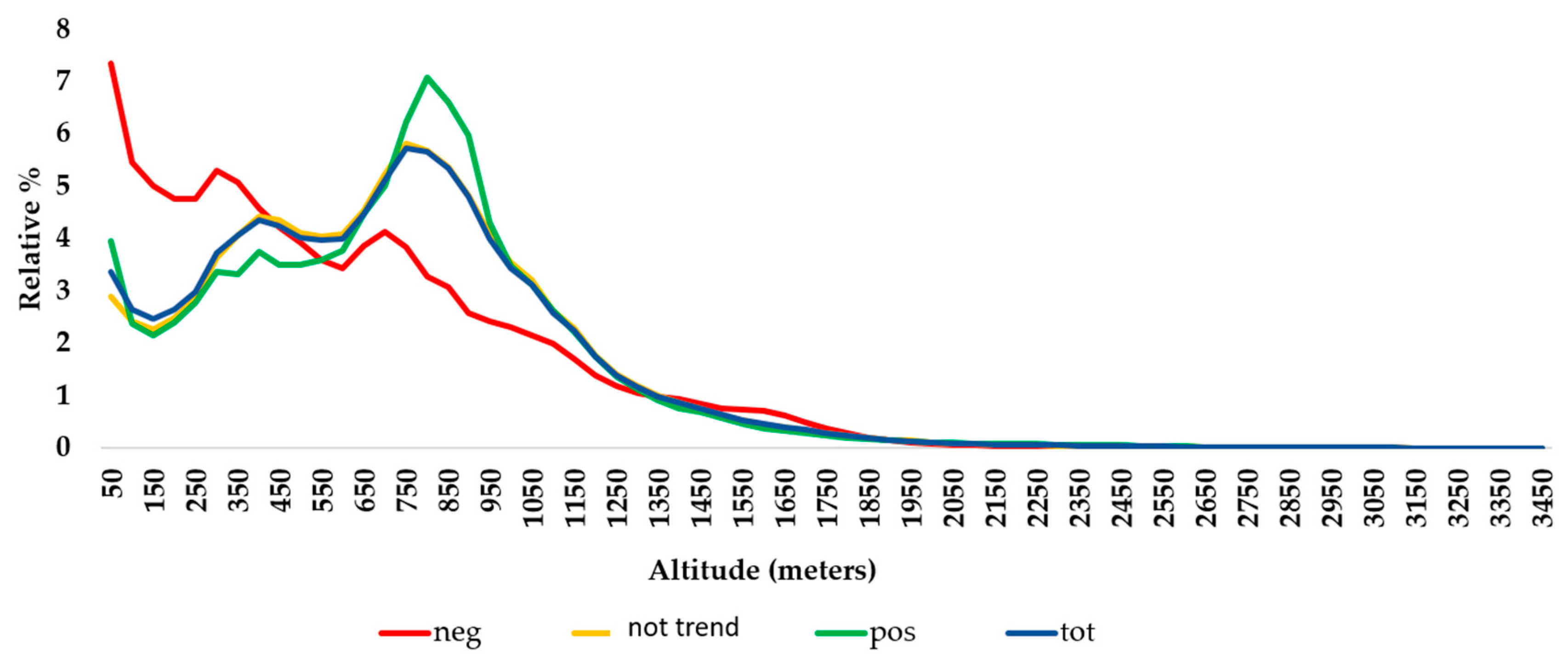
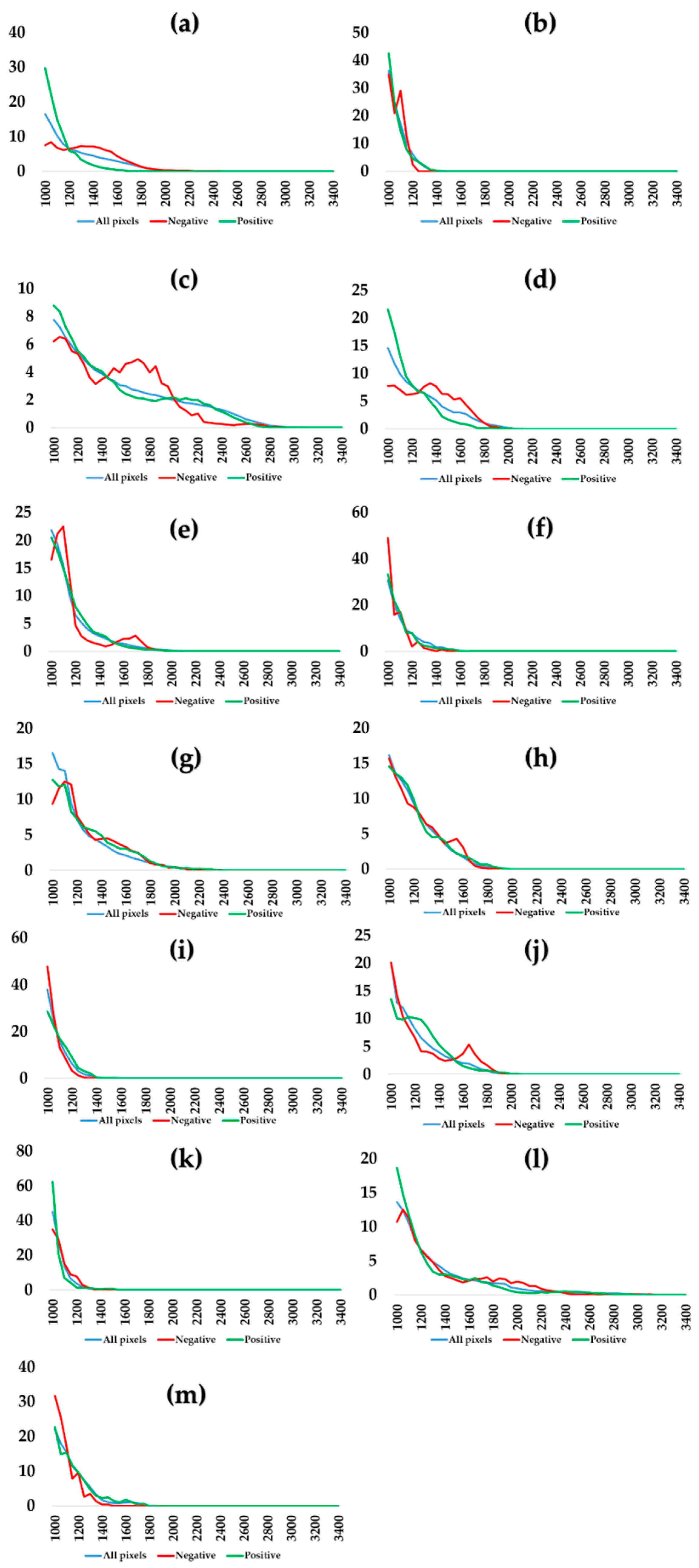

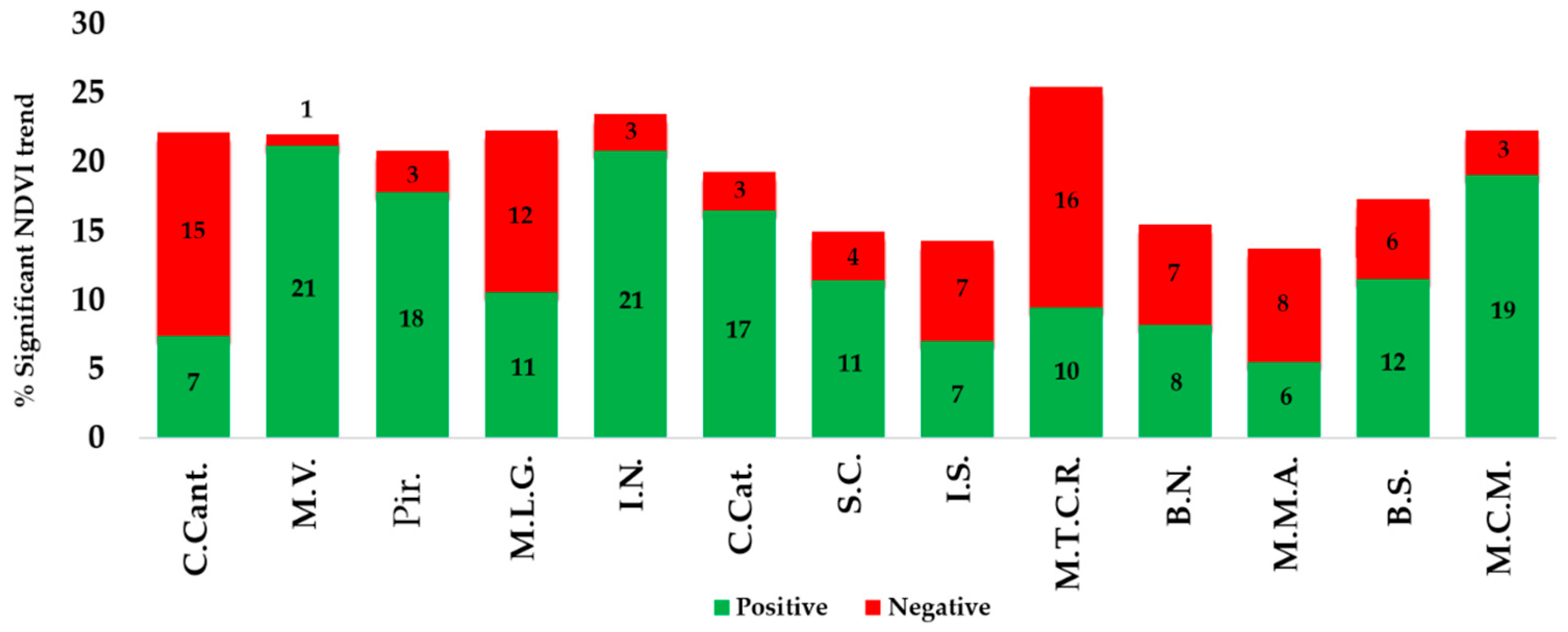
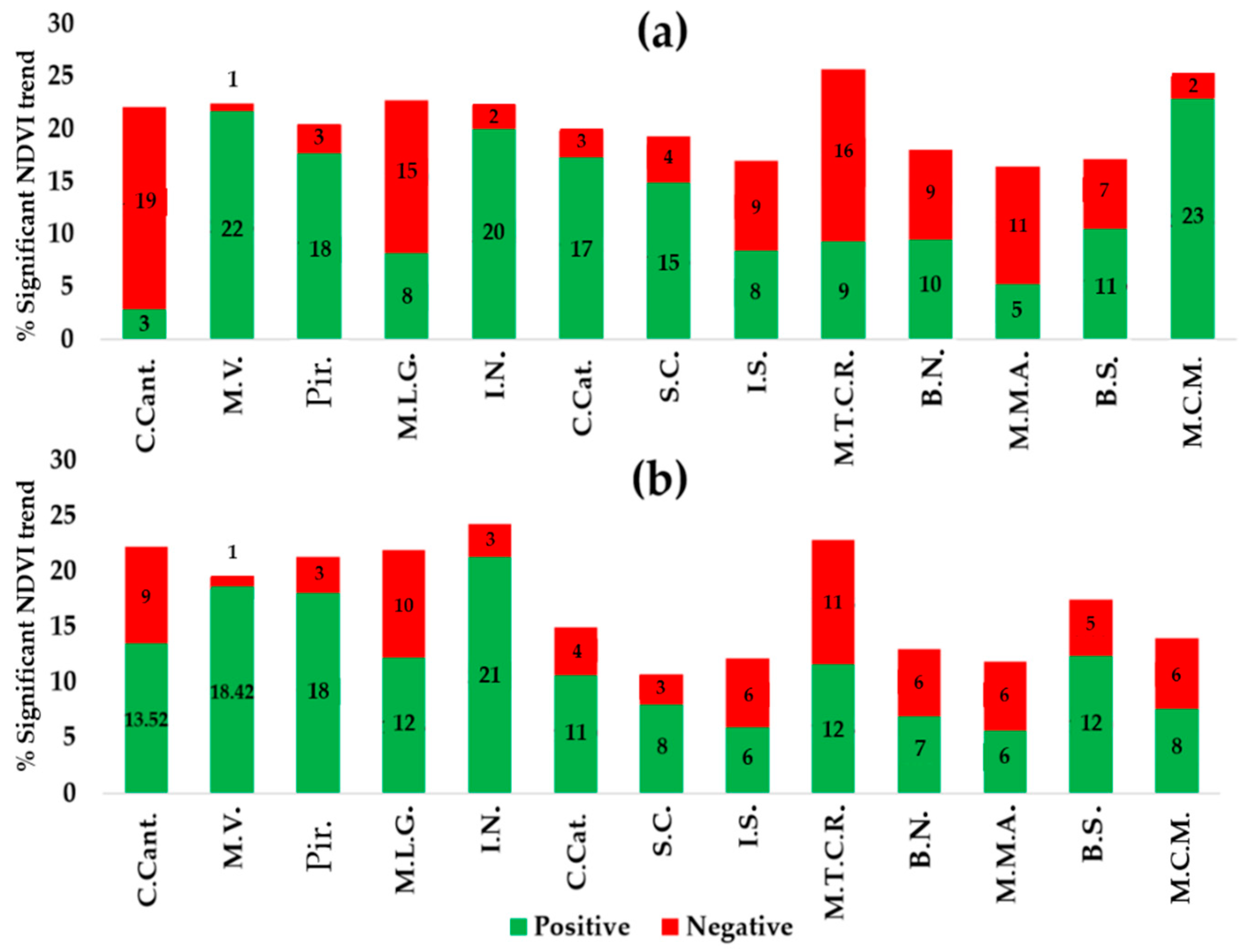



| Mountain Name | Abbreviation | Protected Area | Area of Each Mountain (ha) | Height of Range (m) | Localization within Mainland Spain |
|---|---|---|---|---|---|
| Cordillera Cantábrica | C.Cant. | 57% | 1,407,436 | 2550 | North |
| Montañas Vascas | M.V. | 87% | 1,018,362 | 1500 | North |
| Pirineos | Pir. | 58% | 2,332,004 | 3350 | North |
| Montes de León y Galicia | M.L.G. | 42% | 797,456 | 2150 | North |
| Sistema Ibérico Norte | I.N. | 37% | 1,152,095 | 2300 | Continental |
| Cordilleras Catalanas | C.Cat. | 88% | 56,600 | 1650 | North |
| Sistema Central | S.C. | 50% | 1,277,718 | 2550 | Continental |
| Ibérico Sur | I.S. | 45% | 414,962 | 2000 | Continental |
| Montes de Toledo y Ciudad Real | M.T.C.R. | 42% | 85,842 | 1600 | Continental |
| Béticas Norte | B.N. | 50% | 778,615 | 2350 | South |
| Montes de Murcia y Alicante | M.M.A. | 41% | 38,408 | 1500 | South |
| Béticas Sur | B.S. | 48% | 44,295 | 3340 | South |
| Montes de Cádiz y Málaga | M.C.M. | 75% | 28,485 | 1500 | South |
| Data Used | V1 | V2 | Df | χ² | Sig. |
|---|---|---|---|---|---|
| All pixels | Trend | Mountain | 24 | 75,212 | * |
| All pixels | Trend | Protection | 2 | 6306 | * |
| C.Cant. | Trend | Protection | 2 | 13,603 | * |
| M.V. | Trend | Protection | 2 | 9 | * |
| Pir. | Trend | Protection | 2 | 52 | * |
| M.L.G. | Trend | Protection | 2 | 694 | * |
| I.N. | Trend | Protection | 2 | 156 | * |
| C.Cat. | Trend | Protection | 2 | 23 | * |
| S.C. | Trend | Protection | 2 | 3838 | * |
| I.S. | Trend | Protection | 2 | 2033 | * |
| M.T.C.R. | Trend | Protection | 2 | 26 | * |
| B.N. | Trend | Protection | 2 | 729 | * |
| M.M.A. | Trend | Protection | 2 | 65 | * |
| B.S. | Trend | Protection | 2 | 259 | * |
| M.C.M. | Trend | Protection | 2 | 281 | * |
| Data Used | V1 | V2 | Df | χ² | p-Value |
|---|---|---|---|---|---|
| Pure pixels from the most representative land cover types | Trend | Cover type | 10 | 22,708 | <0.01 |
| Land Cover Name | Cover Type Acronym | Negative | Non-Trend | Positive | Total |
|---|---|---|---|---|---|
| Non-Irrigated arable land | Non-Irri. | 11,575 (2%) | 588,438 (92%) | 38,488 (6%) | 638,502 (100%) |
| Agro-forestry areas | Agro-for. | 628 (2%) | 26,483 (94%) | 1036 (4%) | 28,147 (100%) |
| Broad-leaved forest | Broad-leav. | 64,290 (11%) | 458,565 (82%) | 42,223 (7%) | 565,078 (100%) |
| Coniferous forest | Con. For. | 90,950 (10%) | 703,791 (79%) | 98,131 (11%) | 892,873 (100%) |
| Natural grasslands | Nat. Grass. | 23,285 (5%) | 374,225 (86%) | 38,215 (9%) | 435,724.91 (100%) |
| Transitional woodland-shrub | Tran. Wood-shr. | 35,741 (7%) | 393,357 (75%) | 95,190 (18%) | 524,288 (100%) |
| Total ha | 226,470 | 2,544,859 | 313,284 | 3,084,613 | |
| Total% | 7.00% | 83.00% | 10.00% | 100.00% |
| Mountains | % of Change 2000–2006 | Area (ha) of Change 2000–2006 | % of Change 2006–2012 | Area (ha) of Change 2006–2012 |
|---|---|---|---|---|
| C.Cant. | 0.109 | 10281 | 0.103 | 9715 |
| M.V. | 0.001 | 94 | 0 | 0.00 |
| Pir. | 0.025 | 2358 | 0.003 | 283 |
| M.L.G. | 0.239 | 22543 | 0.178 | 16,789 |
| I.N. | 0.049 | 4622 | 0.033 | 3113 |
| C.Cat. | 0 | 0.00 | 0 | 0.00 |
| S.C. | 0.133 | 12,545 | 0.112 | 10,564 |
| I.S. | 0.185 | 17,450 | 0.188 | 17,733 |
| M.T.C.R | 0.01 | 943 | 0.006 | 566 |
| B.N. | 0.043 | 4056 | 0.067 | 6320 |
| M.M.A. | 0.005 | 472 | 0.002 | 189 |
| B.S. | 0.093 | 8772 | 0.034 | 3207 |
| M.C.M. | 0.001 | 94 | 0.0001 | 9 |
| Σ | 0.893 | 84,230.25326 | 0.7261 | 68,487.77927 |
© 2018 by the authors. Licensee MDPI, Basel, Switzerland. This article is an open access article distributed under the terms and conditions of the Creative Commons Attribution (CC BY) license (http://creativecommons.org/licenses/by/4.0/).
Share and Cite
Arrogante-Funes, P.; Novillo, C.J.; Romero-Calcerrada, R. Monitoring NDVI Inter-Annual Behavior in Mountain Areas of Mainland Spain (2001–2016). Sustainability 2018, 10, 4363. https://doi.org/10.3390/su10124363
Arrogante-Funes P, Novillo CJ, Romero-Calcerrada R. Monitoring NDVI Inter-Annual Behavior in Mountain Areas of Mainland Spain (2001–2016). Sustainability. 2018; 10(12):4363. https://doi.org/10.3390/su10124363
Chicago/Turabian StyleArrogante-Funes, Patricia, Carlos J. Novillo, and Raúl Romero-Calcerrada. 2018. "Monitoring NDVI Inter-Annual Behavior in Mountain Areas of Mainland Spain (2001–2016)" Sustainability 10, no. 12: 4363. https://doi.org/10.3390/su10124363
APA StyleArrogante-Funes, P., Novillo, C. J., & Romero-Calcerrada, R. (2018). Monitoring NDVI Inter-Annual Behavior in Mountain Areas of Mainland Spain (2001–2016). Sustainability, 10(12), 4363. https://doi.org/10.3390/su10124363






